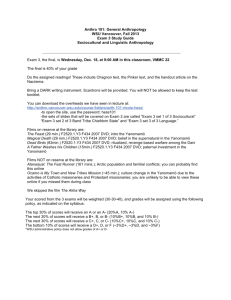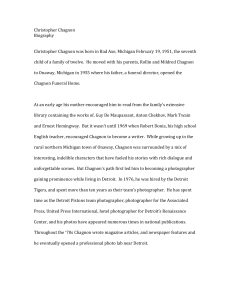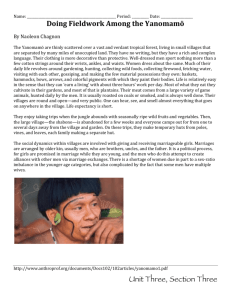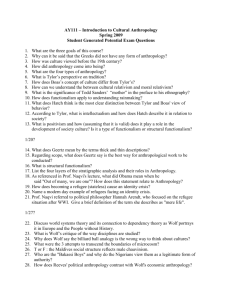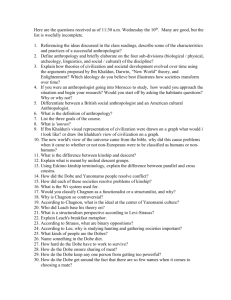Yanomamö Names
advertisement
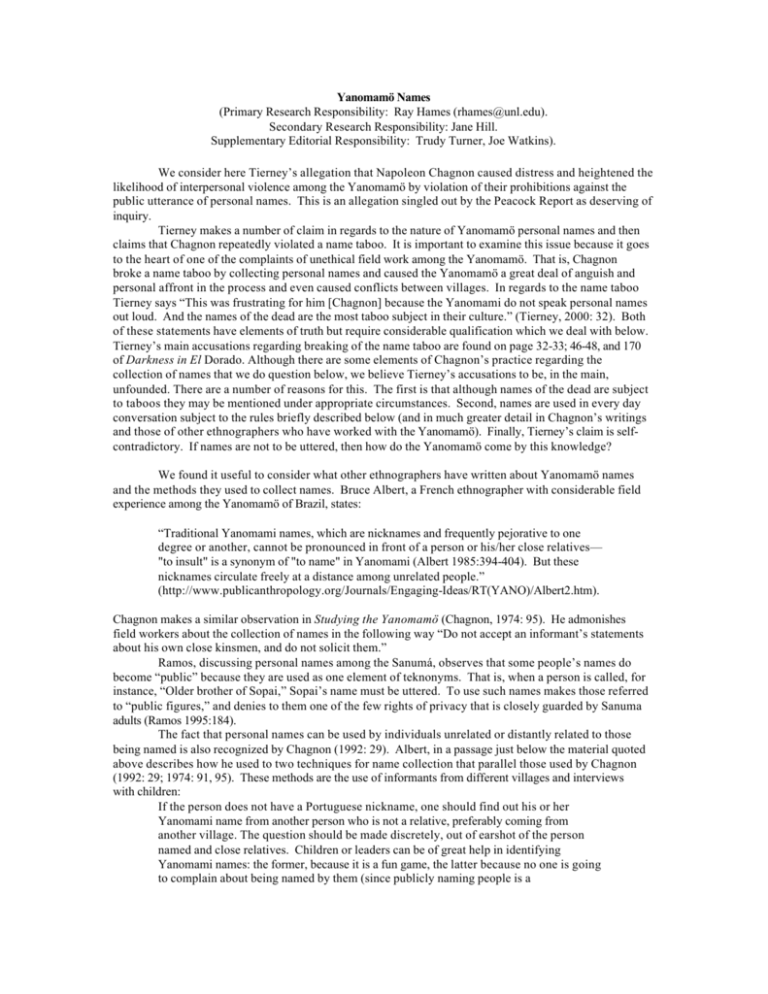
Yanomamö Names (Primary Research Responsibility: Ray Hames (rhames@unl.edu). Secondary Research Responsibility: Jane Hill. Supplementary Editorial Responsibility: Trudy Turner, Joe Watkins). We consider here Tierney’s allegation that Napoleon Chagnon caused distress and heightened the likelihood of interpersonal violence among the Yanomamö by violation of their prohibitions against the public utterance of personal names. This is an allegation singled out by the Peacock Report as deserving of inquiry. Tierney makes a number of claim in regards to the nature of Yanomamö personal names and then claims that Chagnon repeatedly violated a name taboo. It is important to examine this issue because it goes to the heart of one of the complaints of unethical field work among the Yanomamö. That is, Chagnon broke a name taboo by collecting personal names and caused the Yanomamö a great deal of anguish and personal affront in the process and even caused conflicts between villages. In regards to the name taboo Tierney says “This was frustrating for him [Chagnon] because the Yanomami do not speak personal names out loud. And the names of the dead are the most taboo subject in their culture.” (Tierney, 2000: 32). Both of these statements have elements of truth but require considerable qualification which we deal with below. Tierney’s main accusations regarding breaking of the name taboo are found on page 32-33; 46-48, and 170 of Darkness in El Dorado. Although there are some elements of Chagnon’s practice regarding the collection of names that we do question below, we believe Tierney’s accusations to be, in the main, unfounded. There are a number of reasons for this. The first is that although names of the dead are subject to taboos they may be mentioned under appropriate circumstances. Second, names are used in every day conversation subject to the rules briefly described below (and in much greater detail in Chagnon’s writings and those of other ethnographers who have worked with the Yanomamö). Finally, Tierney’s claim is selfcontradictory. If names are not to be uttered, then how do the Yanomamö come by this knowledge? We found it useful to consider what other ethnographers have written about Yanomamö names and the methods they used to collect names. Bruce Albert, a French ethnographer with considerable field experience among the Yanomamö of Brazil, states: “Traditional Yanomami names, which are nicknames and frequently pejorative to one degree or another, cannot be pronounced in front of a person or his/her close relatives— "to insult" is a synonym of "to name" in Yanomami (Albert 1985:394-404). But these nicknames circulate freely at a distance among unrelated people.” (http://www.publicanthropology.org/Journals/Engaging-Ideas/RT(YANO)/Albert2.htm). Chagnon makes a similar observation in Studying the Yanomamö (Chagnon, 1974: 95). He admonishes field workers about the collection of names in the following way “Do not accept an informant’s statements about his own close kinsmen, and do not solicit them.” Ramos, discussing personal names among the Sanumá, observes that some people’s names do become “public” because they are used as one element of teknonyms. That is, when a person is called, for instance, “Older brother of Sopai,” Sopai’s name must be uttered. To use such names makes those referred to “public figures,” and denies to them one of the few rights of privacy that is closely guarded by Sanuma adults (Ramos 1995:184). The fact that personal names can be used by individuals unrelated or distantly related to those being named is also recognized by Chagnon (1992: 29). Albert, in a passage just below the material quoted above describes how he used to two techniques for name collection that parallel those used by Chagnon (1992: 29; 1974: 91, 95). These methods are the use of informants from different villages and interviews with children: If the person does not have a Portuguese nickname, one should find out his or her Yanomami name from another person who is not a relative, preferably coming from another village. The question should be made discretely, out of earshot of the person named and close relatives. Children or leaders can be of great help in identifying Yanomami names: the former, because it is a fun game, the latter because no one is going to complain about being named by them (since publicly naming people is a 2 demonstration of courage). (Albert and Gomez 1997:182-183). (http://www.publicanthropology.org/Journals/Engaging-Ideas/RT(YANO)/Albert2.htm). Whether one can utter the name of an individual and the social circumstances under which it is permissible depends largely on the social status of the individual named, whether the person named is alive or dead, the degree of kinship between the speaker and the person being named, and the presence of others who might overhear the name. Chagnon has described these circumstances in a number of publications (e.g., Chagnon, 1968 [1st edition]: 12; Chagnon, 1974: 91-94; Chagnon, 1992: 23-30; Chagnon, 1997 [5th edition]: 19-21). In general, it is permissible to use the names of children in address or in reference. Likewise, it is permissible to address or refer to women by their personal names. However, it is more polite to use a kinship term to address a woman to whom one is not closely related. Ramos reports for the Sanumá slightly different rules from those prevailing among the Yanomamö. She states that the names of the dead are not the object of special taboos (1995:200), and that Sanumá name secrecy has a “playful” quality in contrast to the dead seriousness about the issue encountered by Chagnon and Albert. She attributes this to the presence among the Sanumá of unilineality; if Sanumá could not say the names of the dead, they would have to give up lineages (Ramos 1995:205). Among the Yanomamö, however, use of personal names for maturing males, mature men, or the dead regardless of sex is subject to a number of stringent regulations (Lizot, 1984: 125-136.). In a public context, it is inappropriate and insulting to address a man by his name or mention the name of a dead relative to a close kinsperson. In a private setting these rules change depending on the social relations and context that exist between speaker and listener. At one end, someone who is not related to a living or dead individual may freely utter that person’s name so long as a close relative of the named is not within earshot. At the other end, it is not permissible to utter the name of a dead person who is closely related to the listener or even to ask the listener to name a close relative. To do so is a grave insult. In fact, if the deceased’s name was a common noun (e.g., tapir) the village in which the deceased resided before death may find a substitute for that term so as to not come close to breaking the name taboo (Lizot, 1984: 132). This practice coincides with Yanomamö belief that all remains of the dead (e.g., body and possessions) along with the name must be obliterated. Nevertheless, this last rule, under very special circumstances, can be legitimately circumvented if one establishes a prior agreement with the person being queried. Specifically, the person giving the name may not be a relative and the name should be whispered into the ear of the listener. Finally , it is also clear from Albert that one is able to legitimately collect personal names although Albert believes that Chagnon may have done this unethically: Here, once again, the atypical "hit-and-run" fieldwork methods used by Chagnon in his frenetic schedule of collecting genealogies and blood for the AEC must have induced him to invent ad hoc measures for getting around Yanomami name secrecy in ways that were more aggressive and less ethical. Had he used the more typical slow pace and low-profile attitude that most anthropologists use during fieldwork, he would never have found himself in situations of having to resort to bribery, trickery, or offensive behaviors to collect names. The chaotic and peripatetic nature of his AEC agenda probably did force him into such situations. (http://www.publicanthropology.org/Journals/EngagingIdeas/RT(YANO)/Albert2.htm). It should be noted that Albert’s statement above about “hit and run fieldwork” seems to be based on a reading of Tierney’s accusations and not a reading of Chagnon’s writings about name collection while working with geneticists (Chagnon, 1974: 93). On this point, Chagnon has written as follows: 2. <italOn once-only visits to a new village do not try to collect genealogies by using namesital>...Much of my collaborative work with medical-genetics colleagues takes place in circumstances such as this. In these cases I write identification numbers on everybody and use kinship terms to discover the <italprobableital> biological relationship among those who are alive (Chagnon 1974:93) We would also add that aside from Bruce Albert, other Yanomamö ethnographers such as Jacques Lizot, Alcida Ramos, Eguillor Garcia, and Marco Ales have collected Yanomamö names (of individuals both living and dead) and published them. Tierney (2000) contains many Yanomamö personal names, some accompanied by photographs. The more interesting claim about the collection of names is that Chagnon used unethical methods 2 3 in his genealogical research by relying on local pariahs, enemies, and children. To some extent, the use of these techniques was a consequence of the Yanomamö providing Chagnon with false information during the initial six month period of field research. This of course, does not excuse Chagnon for the tactics he may have employed to gain correct genealogies, but it does provide a relevant context. Of these three specific accusations it seems to us that the use of children and “bribing” of children is the most questionable. Current U.S. human-subjects regulations require special precautions on the use of children as informants . It seems reasonable to predict that if Chagnon were to submit research protocols that stated Yanomamö children were to be interviewed to collect genealogical information because adults were unwilling or hostile to such queries because of cultural taboos, his protocol would be denied. Even more problematic is Chagnon’s use of the word “bribe” to induce children to reveal true names. Our standard definition of the term suggests that one uses a bribe to induce someone in a position of trust to do something he or she would not otherwise do. Nevertheless, we think it clear from Chagnon’s research that children were only used during his earliest field work. They are an extremely poor source of genealogical information. But it should also be recalled that Albert (see citation above) defends the use of children as genealogical informants because no one take offense at a child uttering the name of an adult. We also note that, apart from payments to children, that appropriate payment for information is accepted under contemporary human subjects regulations, and can be distinguished from “bribing”. The use of enemies and the exploitation of personal animosities between Yanomamö (e.g., reliance on Rerebawä as an informant discussed in Chagnon, 1992: 27) are the other two issues in regards to the collection of names. Tierney states: Finally, he invented a system, as ingenious as it was divisive, to get around the name taboo. Within groups, he sought out “informants who might be considered ‘aberrant’ or ‘abnormal,’ outcasts in their own society,” people he could bribe and isolate more easily. These pariahs resented other members of society, so they more willingly betrayed sacred secrets at others’ expense and for their own profit. He resorted to “tactics such as ‘bribing’ children when their elders were not around, or capitalizing on animosities between individuals.”32-33. In the passage above, Tierney cites Studying the Yanomamö (Chagnon 1974:91). Here is the entire statement: I knew that it would be difficult to work around the name taboo, and I knew that important gains would be made only after I identified the good informants. As happened in Bisaasi-teri, the early good breaks came from informants who might be considered “aberrant” or “abnormal,” outcasts in their own society, individuals like the twelve-yearold Karina, who guided me to Mishimishimaböwei-teri the first time. This statement is about the difficulties Chagnon had early on in his dissertation research, during the first six months. It is unclear what Chagnon means by aberrant or abnormal. In the case of Karina, however, it is clear. Chagnon, 1974: 18) describes him as someone who spent much of his life in Sibarariwä’s village (Mishimishimaböwei-teri) and returned to live in Mömariböwei-teri and was treated badly by his relatives in that village who seemed to consider him a stranger. Nevertheless, it is clear that Chagnon took advantage of aberrant or abnormal individuals to gain information about names. Use of such individuals to divulge difficult to acquire information is not uncommon in ethnographic field work and we need to carefully reconsider this issue. Chagnon, both in his standard ethnography Yanomamö (1997, 5th edition) and in Studying the Yanomamö (1974) provide numerous examples of mistakes he made in the collection of names. He consistently admits he made mistakes and that he learned not to repeat them. Sometimes mistakes recurred after he thought he had made proper precautions (e.g., Chagnon, 1992:30). Yet Tierney seizes on these mistakes as Chagnon’s standard practice when in fact they were not. It is our sense that many of the mistakes Chagnon made around names were honest and unintended and that he learned from these errors. We are, however, concerned about the use of children as informants as well as the use of aberrant and abnormal individuals. While these are “classical” anthropological field techniques, we believe that in today’s environment, of increasing concern for the dignity and autonomy of human subjects, we should open a new dialogue on such methods. 3

